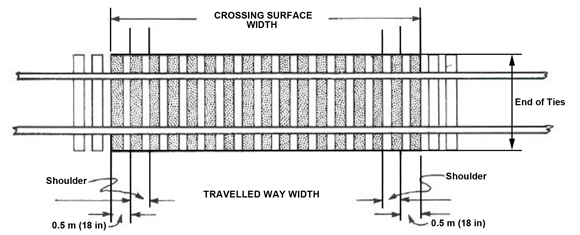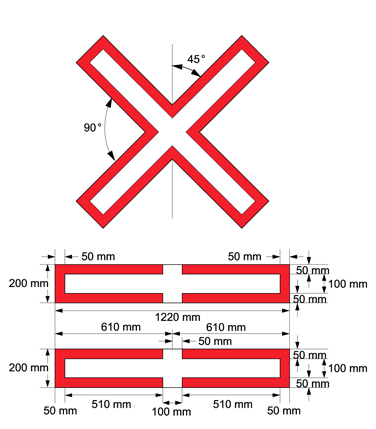3. Crossing Surface
3.1 The crossing surface must be of a width that is equal to the width of the travelled way and shoulders of the road, plus 0.5 m on each side, measured at right angles to the centreline of the road, as shown in Figure 3-1 (a) or (b), as the case may be.
3.2 A flangeway must be provided between the gauge side of the rail and the road surface and must be between 65 mm and 120 mm wide, and between 50 mm and 75 mm deep.
a)
Figure 3-1 – Crossing Surface - Text version
Two plan views of a crossing surface, one without shoulders and one with shoulders, with arrows and dimensions illustrating section 3.1 The dimensions illustrated between the Crossing Surface width and the Travelled Way width are 0.5 m (18 in).
Figure 3-1 b) - Text version
Two plan views of a crossing surface, one without shoulders and one with shoulders, with arrows and dimensions illustrating section 3.1 The dimensions illustrated between the Crossing Surface width and the Travelled Way width are 0.5 m (18 in).
4. Railway Crossing Sign and Number of Tracks Sign
4.1 A sign providing warning of a grade crossing (Railway Crossing sign) must have a 50 mm border of transparent red ink that is silk-screen processed over silver-white sheeting material, as shown in Figure 4-1(a). A sign indicating the number of tracks (Number of Tracks sign) must have a digit and symbol that is transparent red or black ink that is silk-screened processed over silver-white sheeting material, as shown in Figure 4-1(b).
4.1.1 Without Warning Systems
A grade crossing without a warning system must have the following:
- A railway crossing sign.
- The railway crossing signs must be located as shown in Figure 4-2(a) and (b) and must be clearly visible to persons approaching the grade crossing on the road approach.
- The railway crossing signs must be located between 0.3 m and 2.0 m from the face of curb, or outer edge of road approach shoulder; or, where there is no curb or shoulder, 2.0 m to 4.5 m from the edge of the travelled way;
- The railway crossing signs must be located no closer than 3.0 m from the nearest rail;
- Where there is more than one track at a grade crossing, an additional sign indicating the number of tracks to be crossed, must be installed on the supporting post of each railway crossing sign as shown in Figure 4-2(c).
- A sidewalk, path or trail with its centreline more than 3.6 m (12 ft.) from a railway crossing sign supporting post beside a road approach for vehicle traffic must have separate railway crossing signs.
4.1.2 With Warning Systems
A grade crossing with a warning system must have the following:
- A railway crossing sign must be installed as shown in Figures 4-3 and 4-4.
- Where there is more than one track at a grade crossing, a sign indicating the number of tracks to be crossed, as shown in Figure 4-1(b), must be installed on the supporting post of each railway crossing sign.
4.1.3 Reflective Marking Material Specifications
- The reflective material of the signs, referred to in 4.1, must cover the entire front surface of the signs.
- The reflective material must meet the Level 2 reflective intensity values in Table 2 of the 62-GP-11M standard (cited in Part A).
(a) Railway Crossing Sign
Figure 4-1 a) - Text version
Diagram 4-1 (a), uses lines and arrows to illustrate the dimensions and angle of a Railway Crossing sign.
The blades of the Railway Crossing Sign shall be 45 degrees from the centre line of the sign. 90 degrees shall separate each blade. Each blade is white and has a red perimeter that is 50 mm in thickness. Each blade is 200 mm high and 1220 mm wide. From the center of the width of each blade no red shall appear for 50 mm to each side of the center line.
Figure 4-1 b) - Text version
Diagram 4-1 (b), uses arrows to illustrate the dimensions of the Number of Tracks sign.
The Number of Tracks Sign shall have a picture of railway tracks with the number of tracks identified right above. Each tie, of the railway tracks image, is 32 mm wide and there shall be a gap of 93 mm between each tie. The bottom part of the sign is 690 mm wide minimum and 200 mm high minimum. The railway tracks image shall be centered on the sign and the tracks shall be 13 mm thick and the distance between the tracks shall be 76 mm. The top part of the sign consists of a rectangle that is 200 mm wide and between 200 and 229 mm high and is centered with the lateral axis of the bottom portion of the sign. The font of the number shall be Helvetica Medium at 152.5 mm high.
a)
Figure 4-2 a) - Text version
Figure 4-2 has four diagrams. The first three diagrams illustrate the location of the signs on roads of different configuration (angle greater than 90˚, angle 90˚ or less and multi-lane one-way or divided road.) the last diagram shows how Railway Crossing sign and the Number of tracks sign should be placed on the post.
For crossings where the angle between the railway tracks and the roadway is greater than 90 degrees, the intersection between the perpendicular line from the Railway Crossing Sign and the longitudinal axis of the roadway shall be positioned at a minimum of 3 m from the nearest rail.
For crossings where the angle between the railway tracks and the roadway is less than 90 degrees, the Railway Crossing Sign shall be positioned at a minimum of 3 m from the nearest rail.
Figure 4-2 b) - Text version
As provided for under article 4.1.1 (f) a sidewalk, path or trail with its centreline more than 3.6 m (12 ft.) from a railway crossing sign supporting post beside a road approach for vehicle traffic must have separate railway crossing signs.
Figure 4-2 c) - Text version
The Railway Crossing Sign shows that the lowest edge of the blades shall be between 1.5 and 2.5 m from the crown of the road. The Number of Tracks Sign is shown just below the Railway Crossing Sign and the upper edge of the Number of Tracks Sign is in line with the tangent of the lower edges of the Railway Crossing Sign. The center of the Railway Crossing Sign is 0.5 m above the top of the Number of Tracks Sign.
The Railway Crossing Sign shall be positioned perpendicular to the longitudinal axis of the roadway.
Figure 4-3 - Text version
Grade crossing warning system of flashing light type assembly and the placement of the number of tracks sign.
Figure 4-4 - Text version
Warning system assembly with gates and the placement of the number of tracks sign.
The gate arm has 3 flashing lights positioned just above the gate arm.





